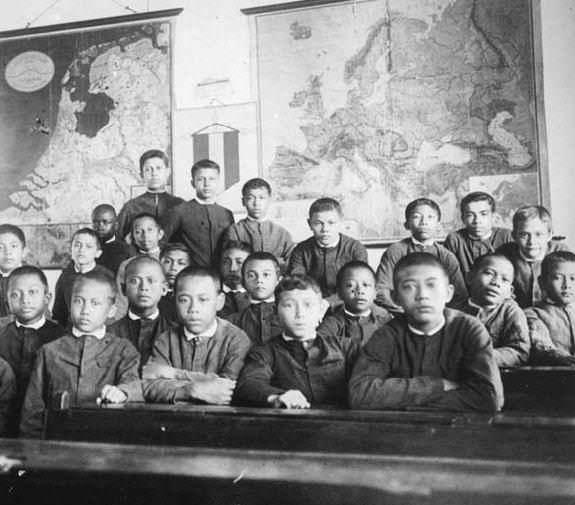school cadet programs : Dutch East Indies

School Cadet Programs: Dutch East Indies

Figure 1.--This photograph probably taken about 1910 shows a classroom scene of the Korps Pupillen. The boys all had Dutch fathers. They wear a collar buttoning jacket. I'm not sure what color the iniform was. Many have close-cropped hair, although the more European-looking boys tend to have slightly longer hair.
|
No information is available on cadet programs in the former Dutch colonies oversea. Dutch military sources indicate that there were no formal cadet program operating in Dutch colonies. A HBC reader, however, reports that there was a small program in the Dutch East Indies (DEI)--the Korps Pupillen. We are not sure that it was sanctioned by the Dutch military. The Korps Pupillen existed at Gombong, Java, from 1850 till 1912. I do not know of comparable instotutions elsewhere in the DEI. The Korps appears to have been composed of Eurasian boys 9-16 years of age. Most of the boys were orphans. Their training reportedly followed a strict military pattern. HBC has received some vary accounts and we are in the process of reassessing this page.
Terminology
The Dutch word pupil (pl. pupillen) as used here is obsolete. It is equivalent to what the British would call a ward of the court. I am not sure though what a similar institution would be called in English. A reformatory is definitely too strong a term, suggesting that the children had misbehaved and required corrective guidance. Some may have gotten into trouble, others may have just run away from home. Something more like an orphanage might be a better translation, although the children apparently were rather unruly.
The Korps Pupillen
A HBC reader has provided information from a DEI source describing the experiences about a Dutch teacher named Van Bommel in the early 1900s. The source reads, "Van Bommel taught in Gombong at the so-called Pupillenschool, established 1850 and discontinued
1912. Article 1 of the rules and regulations states that it intended to educate children of the male gender for the military. These were children 9 to 16 years of age, issue of
Dutch soldiers and Indonesian women, most of them orphans who were at risk of becoming decadent and could easily come to criminal behaviour. The institute was run along military lines. The official name was the 'Korps Pupillen'. Strict military discipline was enforced. Punishment was by close arrest on rice and water or by emprisonment. Corporal punishment was by caning. .... The curriculum included reading, writing, mathematics, and also geography and Dutch history. Notice the wall maps. Van Bommel used to say that at Gombong life was more like taming lions than like teaching." Apparently there was atvleast some attempt to provide a cultural education as well. We know that the cadets received music instruction. A HBC reader reports that his grandfather was the music teacher. [Fornerod]
Wards of the Court
HBC was unsure why the boys were wards of the court. We assume this meant that they had not been accepted by their Dutch army fathers or that they had gotten into trouble with the law. A Dutch reader responded, "I do not follow your interpretation that these boys had not been not accepted by their fathers. Quite the opposite. For one thing the Dutch word used here for ward of the court implies that their parents had died and not abandoned their child. For another, if a Dutch father did not own to his natural child, he or she would henceforth count as a native. There was a set expression for this in Malay: masuk kampung (literally: enter the kampong). The expression is used to this day for illegitimate offspring of upper-class Indonesians. In a colonial society such children would not have had a chance of entering a state-run institution that had been established expressly for Eurasians. (If Church-run, now that would have been different). Their presence in this class implies that they had been registered as Eurasians (Indo-europeanen in Dutch colonial terms) and therefore acknowledged by their fathers."
Orphans
The one who took care of Indo-European orphans in the Dutch East Indies was "Pa" van der Steur, who established schools and homes for them. The children were called "Steurtjes". As far as I know they did not wear a uniform. ut van der Steur made sure that they became productive members of society at that time. [Cotati]
Reader Comment
Another Dutch reader informs us that he has found some limited information about this Korps in the Koninklijke Bibliotheek, The Haque. They have a guide on microfiche: Het Korps Pupillen te Gombong, Gids voor belanghebbenden en belangstellenden, by C.F.H. Campen, printed 1886 in Batavia. He informs us that, "The information you give is not quite right. The Korps was founded by Luitenant-Kolonel Von Lutzow and began with his officers. The Korps was made official by royal decree (October 28, 1847). The purpose was to bring up the male children that the Dutch soldiers had with their local houskeepers. (Marriage was not allowed.) Otherwise these children would not have had the opportunity to obtain an education." [Lups]
Sources
Cotati, Rudi. E-mail July 24, 2002.
Fornerod, M. E-mail, July 4, 2003.
Lups, H.M. E-mail November 26, 2002.
HBC

Navigate the HBC Cadet Pages
[Return to the Main Dutch cadet page]
[Return to the Main Cadet page]
[Australia]
[England]
[New Zealand]
[Russia]
[Scotland]
[South Africa]
[United States]
Navigate the Historic Boys' Clothing Web Site:
[Return to the Main military page]
[Introduction]
[Activities]
[Biographies]
[Chronology]
[Clothing styles]
[Countries]
[Uniforms]
[Youth groups]
[Bibliography]
[Contributions]
[Essays]
[FAQs]
[Glossaries]
[Satellites]
[Tools]
[Boys' Clothing Home]
Created: July 23, 2002
Last updated: July 4, 2003



